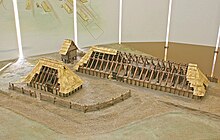Feddersen Wierde
- Machine translation, like DeepL or Google Translate, is a useful starting point for translations, but translators must revise errors as necessary and confirm that the translation is accurate, rather than simply copy-pasting machine-translated text into the English Wikipedia.
- Consider adding a topic to this template: there are already 1,897 articles in the main category, and specifying
|topic=will aid in categorization. - Do not translate text that appears unreliable or low-quality. If possible, verify the text with references provided in the foreign-language article.
- You must provide copyright attribution in the edit summary accompanying your translation by providing an interlanguage link to the source of your translation. A model attribution edit summary is
Content in this edit is translated from the existing German Wikipedia article at [[:de:Feddersen Wierde]]; see its history for attribution. - You may also add the template
{{Translated|de|Feddersen Wierde}}to the talk page. - For more guidance, see Wikipedia:Translation.

Feddersen Wierde is a former Iron Age wierde settlement located on marshland on the Weser estuary, 14 km north of Bremerhaven, Germany. It was inhabited from the 1st to 5th centuries AD.[1][2]
History
Settlers used dung and mud to gradually form a wierde, raising the settlement in a mound shape to better withstand flooding. In the 3rd century AD, the settlement had an estimated 300 inhabitants, 450 cattle, and 26 farmsteads, the majority of which were longhouses made of timber.[1][3] Settlers grew various cereal grains; meat and seafood made up little of their diet.[2]
Abandonment
The settlement began to decline during the 5th century AD and was completely abandoned by 450 AD. It is believed that some settlers, as part of the Central Europe's larger trend of westward migration during the period, moved to the Low Countries and eastern Britain.[2]
Excavations
Excavations were performed by the Lower Saxony Institute for Historical Coastal Research from 1955 to 1963. Organic materials, such as building foundations and bone tools, were well preserved due to the layers of flooring maintaining humidity.[4]
See also
- Wierde
References
- ^ a b Rau, Andreas (2018). The Oxford Dictionary of Late Antiquity. Oxford University Press. ISBN 9780198662778.
- ^ a b c Todd, Malcolm (2012). Silberman, Neil Asher (ed.). The Oxford Companion to Archaeology (2 ed.). Oxford University Press. ISBN 9780199735785.
- ^ Darvill, Timonthy (2021). The Concise Oxford Dictionary of Archaeology (2 ed.). Oxford University Press. ISBN 9780191842788.
- ^ Struckmeyer, Katrin (2011). The bone tools from the dwelling mound Feddersen Wierde, Germany, and their functions. Institute of Archaeology, University of Wroclaw. ISBN 978-83-61416-64-7.









